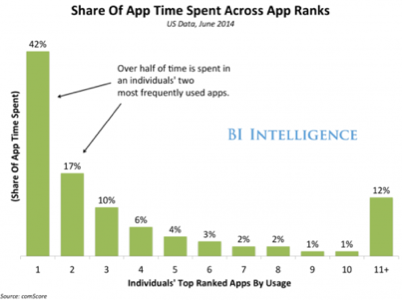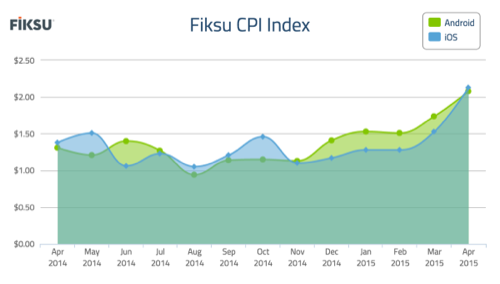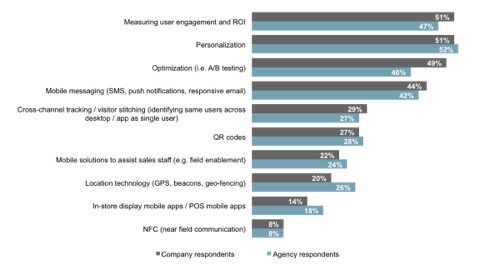We’re in love with apps.
Recent figures from Web application design and development company Go-Globe reveal that we now spend 89% of our mobile time in apps, and we’re spending 21% more time in them now than last year. In fact, apps are so big that 52% of all time spent in digital media happens inside apps.
That behavior translates into mountains of cash for some companies. I spoke with one U.S. retailer who will do $2 billion of in-app sales this year. Inspiring—or at least it might be, if not for the sobering reality that this tends to be the exception rather than the rule.
Over the past few years, the average number of apps that people use has remained constant at 27, according to Nielsen data, with 70% of all app use spent in the top 200 apps. Recode recently pointed out that 25% of apps are used once, then get deleted by fickle users.
As a developer—whether retailer, game maker, or financial services company—your primary goal is to become an essential part of your users’ app-happy day. And your only hope to get there is by using data. Lots and lots of data.
Standing Out In The Crowd
Despite the euphoria around mobile apps, a recent BI Intelligence report offers a dose of reality. Turns out, more than half of in-app time is spent inside a user’s two favorite apps.

While a brand might be tempted to shoot for one of the top slots, those spots tend to go to Facebook or messaging apps such as SnapChat. And, to channel Senator Lloyd Bentsen in his vice presidential debate with Senator Dan Quayle, “You’re no Facebook.”
See also: Funding The Web With Ads: This Outdated Model Has To Go
Things don’t look any better when you dig further into the numbers either.
- U.S. app users download an average of 8.8 apps per month, the same as three years ago.
- Roughly 52% of apps lose half their peak audience within three months of installation.
Lest you think that the hard part is done once someone installs an app, this drop-off rate suggests otherwise.
Adding insult to injury, the cost of driving app installations is soaring—up 54% (iOS) and 59% (Android), respectively, according to mobile-marketing tech firm Fiksu.

Keeping users is no easy task either, with the cost of retention also on the rise. So what’s an app developer to do?
What Would Google Do?
A “morass of confusion” seems to plague developers, as they try to figure out an effective mobile strategy. But much of that confusion stems from misguided app strategies, which often go heavy on launching an app, but skew too light on data.
In other words, in the “there’s an app for that” rush to build, most companies overlook the importance of making apps live up to their promise—a potential only realized through very big data.
Consider Google.
Though the company distributes Android, its really interesting mobile work doesn’t run on a device at all. As Redmonk analyst Stephen O’Grady notes, Google’s mobile strategy is all about the cloud.
Google’s vision for computing is clearly cloud centric, and more particularly driven by the aggregated of value of millions of users living in the same cloud. The same way that Google can determine where traffic is congested by noticing that thousands of GPS-enabled Android devices are slowing down is the same way that the company can determine that because a million fans of obscure band A have liked obscure band B means that there’s a reasonable chance you will too.
Services like Google Now and even Google Maps depend on data, leading O’Grady to conclude that “the single most important asset for Google is not…software, but access” to user data from millions of devices.
This is as true for Google as it is for any company building apps—which is pretty much every company now.
There are basic blocking and tackling strategies for mobile. One such component is ensuring your company has a mobile-friendly site, so its Google rank doesn’t tank—as happened with roughly 50% of non-mobile friendly sites recently. But data is bigger, harder, and much more fundamental to long-term success.
Get Some Data…Now
Fortunately, more companies have stepped forward to help put data to use for mobile initiatives.
Emergence investor Joseph Floyd singles out a few, but the key is to look for partners that help understand mobile users’ established behavior, as well as predict what users want to see at optimal moments. These companies style themselves as “mobile marketing automation” companies, but really, this is much bigger than marketing.
It’s about transforming a business through mobile and, more specifically, through mobile data. In other words, cloud data made useful in a mobile context.
Fortunately, we’re starting to see companies grok this. When asked about mobile priorities, they put personalization and optimization—both heavily data-driven—at the top of the list, according to an Adobe/eConsultancy survey.

It’s a great start, but that only scratches the surface. To succeed in mobile, you need a more comprehensive look at what your users do and what they value. You need more data. Much more.
Fixating on wireframes and the look and feel of your app is important, but insufficient on its own. Instead, spend more time thinking about user data, and how you can use it to deliver an exceptional experience. That’s the only chance your app has of breaking into the 27 apps users will turn to—much less the top few where they will spend 70% of their time.
Lead photo by JD Hancock










